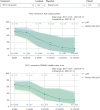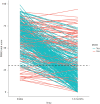Closing the loop: a 10-year experience with routine outcome measurements to improve treatment in hand surgery
- PMID: 34267934
- PMCID: PMC8246110
- DOI: 10.1302/2058-5241.6.210012
Closing the loop: a 10-year experience with routine outcome measurements to improve treatment in hand surgery
Abstract
Routine outcome measurements as a critical prerequisite of value-based healthcare have received considerable attention recently. There has been less attention for the last step in value-based healthcare where measurement of outcomes also leads to improvement in the quality of care. This is probably not without reason, since the last part of the learning cycle: 'Closing the loop', seems the hardest to implement.The journey from measuring outcomes to changing daily care can be troublesome. As early adopters of value-based healthcare, we would like to share our 10 years of experience in this journey.Examples of feedback loops are shown based on outcome measurements implemented to improve our daily care process as a focused hand surgery and hand therapy clinic.Feedback loops can be used to improve shared decision making, to monitor or predict treatment progression over time, for extreme value detection, improve journal clubs, and surgeon evaluation.Our goal as surgeons to improve treatment should not stop at the act of implementing routine outcome measurements.We should implement routine analysis and routine feedback loops, because real-time performance feedback can accelerate our learning cycle. Cite this article: EFORT Open Rev 2021;6:439-450. DOI: 10.1302/2058-5241.6.210012.
Keywords: dashboard; patient-reported experience measurements; patient-reported outcome measurements; scorecard; surgeon feedback loop; value-based healthcare.
© 2021 The author(s).
Conflict of interest statement
ICMJE Conflict of interest statement: MJWVDO reports grants/grants pending from the FESSH/Foundation for Hand Surgery Clinical Research, outside the submitted work. RMW reports a grant to perform research from ZonMW, related to the submitted work. SERH reports he is a part-time practising hand surgeon and board member for Equipe Zorgbedrijven and payment for lectures including service on speakers bureaux from scientific institutions for lectures in general, all outside the submitted work. The other authors declare no conflict of interest relevant to this work.
Figures









References
-
- Porter ME. A strategy for health care reform: toward a value-based system. N Engl J Med 2009;361:109–112. - PubMed
-
- Boyce MB, Browne JP, Greenhalgh J. The experiences of professionals with using information from patient-reported outcome measures to improve the quality of healthcare: a systematic review of qualitative research. BMJ Qual Saf 2014;23:508–518. - PubMed
-
- Porter ME. What is value in health care? N Engl J Med 2010;363:2477–2481. - PubMed
-
- Selles RW, Wouters RM, Poelstra R, et al. ; Hand-Wrist Study Group. Routine health outcome measurement: development, design, and implementation of the hand and wrist cohort. Plast Reconstr Surg 2020;146:343–354. - PubMed
-
- ©GemsTracker, Erasmus MC, Equipe Zorgbedrijven, version 1.8.7, open source (new BSD licence), 2011. https://gemstracker.org (date last accessed 24 February 2021).
Publication types
LinkOut - more resources
Full Text Sources
Research Materials

